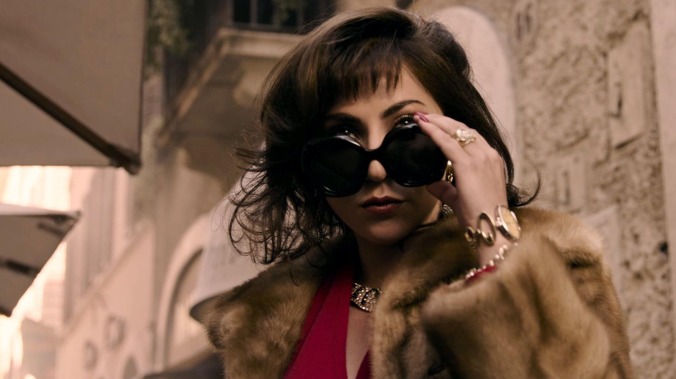House Of Gucci never reaches camp nirvana, even with Lady Gaga on its runway
Ridley Scott's melodrama about the Italian fashion family has its moments, but not enough of them


House Of Gucci rests on an elevated pedigree: Its cast is star-studded, its production design extravagant, its director A-list. (This is the second Ridley Scott movie to hit theaters in as many months.) Yet the publicity around this fashion-world biopic has been closer to the lead-up to a juicy TV-movie biopic like Britney Ever After or Lifetime’s own House Of Versace. The initial announcement prompted a euphoric reaction from fans, followed by giddy rubbernecking as paparazzi photos began leaking from the set. Trailers and pre-release interviews continued to build hype. Did you hear that Lady Gaga stayed in character for a year and a half? Or that Jared Leto underwent a complete physical transformation? By now, the week of release, you wonder if the movie could ever live up to the one audiences have built in their heads.
Gaga certainly brings moments of spidery chic to her role as couture-clad Lady Macbeth Patrizia Reggiani (neé Gucci), while Leto does indeed confound, under mounds of prosthetics, as luxury failson Paolo Gucci. But you’d have to squint pretty hard to see a howling high-camp romp in House Of Gucci. Instead, what we get is a fact-based family melodrama, and a rather meandering one at that. Any movie that inspires Al Pacino to go full Heat can’t be written off entirely as a kitsch artifact, but for the most part Scott leaves the exaggerated Italian expressiveness to his cast—or, to be more specific, half of it.
For while Gaga and Leto are chef’s kissing to the Milanese rafters, Adam Driver (as Gucci heir Maurizio) and Jeremy Irons (as Gucci patriarch Rodolfo) stick to a more earthbound school of acting. And so they form the bumpers off which their co-stars ping. That has its pleasures, particularly in the pairings of Gaga and Driver and Leto and Pacino (who plays Paolo’s disappointed dad, Aldo Gucci). The former are more convincing early on in the film, where the interplay between the passionate Gaga and more reserved Driver reflects the heady early days of the characters’ relationship. Meanwhile, Leto and Pacino keep rising to meet each other’s level, whipping their scenes into a gesticulatory frenzy that provides some of the film’s more outrageous moments.
Salma Hayek does the same for Gaga as a TV psychic-turned-close confidant, but that’s not until late into this 157-minute film. We begin in the late ’70s, when Gucci was a family business (an aristocratic one, but family owned nonetheless) and Patrizia simply a secretary at her father’s modest trucking business. A chance encounter at a disco party leads to an exhilarating romance, but the free spirit and proletarian directness that Maurizio loves about Patricia are the same qualities that make her a less-than-desirable bride for a Gucci. They get hitched anyway, and Patrizia takes to the upper-class Gucci lifestyle like she was born to it. She also develops some strong opinions about how Gucci should be run, setting off a chain of events that eventually leads to murder.
There’s a lot of plot in House Of Gucci, whose story spans decades and continents. There are also a lot of bizarre one-liners, from a script that’s the movie’s weakest asset. (These, of course, sound silliest in Leto’s cartoon pizzaiolo accent.) But rather than submit to going over the top, Scott keeps the filmmaking on a relatively even keel, balancing out the excesses of both the characters and the cast. The director’s overkill is mostly auditory: He dots the film with blindingly obvious ’80s needle drops and works in odd, incongruous sound effects—at one point, a scene of Gaga crying is soundtracked by cats yowling in the background.
Both of these techniques play like a tacit acknowledgement of the inherent vulgarity of the enterprise, a movie about people for whom too much was never enough. Mauricio and Patrizia’s rapacious appetites for luxury are rendered with an eye for detail: The film opens with a closeup of Driver’s wrist adorned with an absurdly expensive watch, and every table around which our characters gather is piled high with wine glasses, espresso cups, and overflowing ashtrays. Figures like Anna Wintour, André Leon Talley, and Karl Lagerfeld—seen front row at a fashion show with his beloved cat Choupette—make fictionalized cameos, providing amusing Easter eggs for students of fashion history. And of course, Gaga’s outfits are to die for, although she doesn’t reach her full diva potential until it’s almost too late.
The movie could easily become too much as well. That it doesn’t is both admirable and disappointing. On the one hand, Gucci comes so close to flowering into something bonkers that its more moderate tendencies feel like a tease. On the other hand, keeping the movie itself in check gives Gaga’s star an opportunity to burn even brighter: She might not deliver the most subtle performance, but she’s certainly magnetic. In the end, however, Patrizia Reggiani’s Wikipedia page is more entertaining than the middle hour of House Of Gucci. Maybe they’re saving the brain tumor and the pet parrot for the sequel?